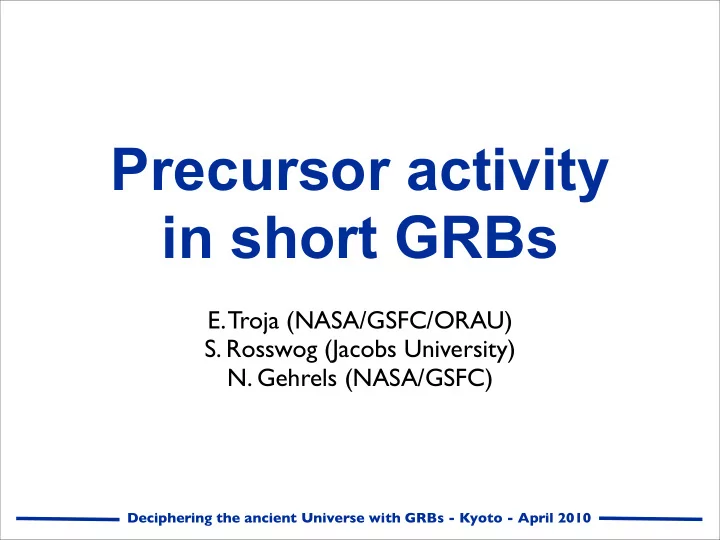

Precursor activity in short GRBs E. Troja (NASA/GSFC/ORAU) S. Rosswog (Jacobs University) N. Gehrels (NASA/GSFC) Deciphering the ancient Universe with GRBs - Kyoto - April 2010
Outline brief summary of precursors in GRBs search of precursors in the sample of Swift short GRBs: method and results implications for LIV measurements precursors in the merger scenario
Precursors emission preceding the GRB less intense than the main GRB non-thermal spectra delays 1-100 s ~20% of long GRBs time since trigger [s] Lazzati 05 theoretical interpretations: fireball : optically thick optically thin very short delays (~0.02-0.2 s) jet breakout : collapsar progenitor Morsony et al. 07
Search in Swift short GRBs SAMPLE: 38 short GRBs (T 90 < 2 s) 11 short GRBs with Extended Emission detected by Swift /BAT up to January 2010 OPERATIONAL DEFINITION 1) peak flux smaller than the main event 2) flux returns to the background level 3) same location in the sky FIRST STEP wavelet algorithm (>3 sigma) on the BAT light curves 6 candidates, but ~2 spurious are expected SECOND STEP cross check with other instruments (e.g. Fermi/GBM) THIRD STEP image domain (>5 sigma)
Light curves 2 precursors in GRB090510 T 0 -0.5 s also seen by Fermi/GBM T 0 -13 s not seen by GBM, but consistent 5.2 in the image σ probability of being noise <10 -5
LIV constraints GRB 090510 high energy emission (up to 31 GeV) by Fermi /LAT z =0.903 (spectroscopic from host) no evidence of LIV: exclude a linear energy dependence of photon-propagation speed Abdo et al. 2009 a) DisCan method ( Scargle, Norris & Bonnell 2008 ) M QG > 1 . 22 M P l b) emission time of the HE photons > onset of the low energy emission (GBM) | ∆ t | < 859 ms M QG > 1 . 19 M P l emission in BAT starts ~13 s earlier M QG > 0 . 09 M P l
Precursors from mergers Interaction of NS magnetospheres Hansen & Lyutikov 2000 system: old recycled pulsar + magnetar prediction: X-ray transient a few seconds before the merger (GRB) � 2 � � B a � − 7 L ≈ 7 × 10 45 erg s − 1 10 7 cm 10 15 G merger time scales ~ 10 5 yr Belczynski et al. 2002, 2006 NS flares from tidal induced crust cracking � − 3 � R ns � 4 � m ns τ tg ≈ 62 min ǫ − 4 / 3 c , − 6 1 . 4 M ⊙ 10 km L ≈ 10 46 erg s − 1 � σ MAX � Horowitz & Kadau 2009 0 . 1 similar to SGR, not visible beyond 40-80 Mpc
Precursors from mergers A relativistic jet ploughing through a pre-ejected wind ? After the merger supermassive NS + torus neutrino-driven baryonic wind Ruffert et al. 1997 Rosswog & Ramirez-Ruiz 2002 Dessart et al. 2009 standard BH+ torus relativistic jet if it works: - central engine activity longer than ~2 s - extend the temporal window of GW searches
Summary ~8% of short GRBs has a precursor (20% in long GRBs), no short GRB with EE delays 2-10 s, one GRB with 2 precursors implication for LIV measurements precursors in the merger scenario: - NS flares from crust cracking - interaction of NS magnetospheres - jet/wind interaction: in progress in the last case it marks the start of central engine activity
Backup
Summary 090510 − 1st 050724 090510 − 2nd 080702A 091117 3 Precursor Hardness ratio 081024A 2 1 0 0 0.5 1 1.5 2 GRB Hardness ratio
Recommend
More recommend